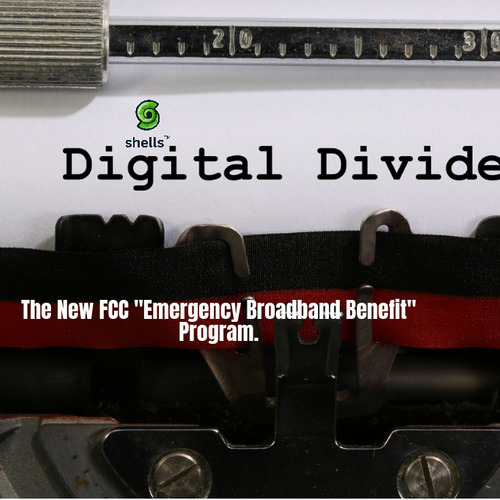There was a time when having Internet access was a luxury, a "plus," but that time is long gone. In this dire time of social distancing since the pandemic hit, the Internet provides a vital link to a host of amenities: work, school, grocery store, pharmacy, bank, emergency services, medical appointments, to name a few.
An Internet connection can make the difference between life and death. Having to travel to get essential goods and services, instead of ordering them safely from home, can compromise our safety and that of our loved ones. According to the pew research center, one-third of broadband users report they fear not being able to afford service during this pandemic.
Millions of Americans did not have that adequate home broadband connection and the long-standing digital divide has morphed into a monstrosity that should be the focus of our collective efforts. In 2021, people of color are still by a wide margin significantly less likely to have the home brand home broadband connection that they need.
For all these reasons, the FCC has launched the “Emergency Broadband Benefit”, a program intended for struggling households, covering tribal lands as well. Last December Congress passed a bill to build, from scratch, a new subsidy program that would financially support the cost of broadband service to households and families struggling during this pandemic. Congress also directed 3.2 billion dollars to fund the program which will provide discounts of up to $50 a month for internet service and up to $75 a month for the same service on tribal lands.
it will also provide eligible consumers an opportunity to receive a discounted computer or tablet if they contribute $10 to $50 towards its purchase cost.
Who is eligible to the Emergency Broadband Benefit program?
According to the FCC, a household should be eligible to benefit from this program if :
- They already subscribe to a broadband access offer targeted at low-income households.
- Their income </= 135 % of the federal poverty guideline OR at least one family member is subject to a public assistance program such as Medicaid.
- A child within the household gets low-cost or free meals from school.
- A job loss or income reduction occurred within the past year.
- The household resides on tribal Native-American land (a higher discount, up to $75 a month).
The FCC stated that it will be developing the enrollment structure within the next couple of months as well as spend the next two months developing the enrollment system and enlisting high-speed internet providers.
More information about the application process and program updates will be available on the FCC’s website. A start date has not been decided yet.
The digital divide in a time of Pandemic
Flashback: March 2020. At the height of the Covid-19 pandemic, 4 billion human beings were confined: closure of schools, sudden cessation of activities, 130 countries placed under lockdown. The Earth seems to stop turning but never ceases communicating. Because even if we are physically distant from each other, we still have this intrinsic need to share, communicate, cooperate and learn. So how can we socialize at a distance? The answer was not hard to find: A screen and a good Internet connection.
By pushing us into our corners, the health crisis has clearly accelerated the global transition to a digital economy. In just a few days, the Zoom videoconferencing platform went from 10 million to 200 million users. Other platforms such as Hangouts, Jitsi, and Teams have seen their audience explode, leading to fears of a total network blackout.
The Covid-19 crisis had this unexpected "butterfly effect": its wings flapping in China triggered a digital tsunami on the planet. All of a sudden, companies adopted new work organizations, facilitated by videoconferencing, and cloud computing tools. School closures paved the way for e-learning. The lockdown has also multiplied virtual courses (cooking, coding, music, etc.) and intensified the use of social networks. Very clearly, our economy is going digital and is transforming the world into a vast digital landscape whose roads are paved by broadband.
Unfortunately, not everyone is equipped to respond to this new digital injunction. Not everyone has an Internet connection or even sufficient computer knowledge. In this respect, Covid-19 has widened the gap. Worse, the pandemic has reinforced existing inequalities to create new ones, on the scale of a region, a nation, and even the world. Let's keep in mind that even today, 3.6 billion people in the world still live without an Internet connection. That's half the world! And the situation is worse in developing countries, especially on the African continent where the connectivity rate is no more than 30%.
The risk, of course, is that this digital divide will turn into a gaping rift between hyper-digitalized societies on the one hand and under-connected countries on the other, de facto creating a "digital third world" and “digital ghettoes” as the transformation accelerates. But can we limit the perverse effects of digital technology? Can we avoid this abyssal divide?
Yes, because the divide is not new. The crisis has only exacerbated a growing phenomenon resulting from a lack of equipment and assistance, low speeds, and areas without Internet or a stable power supply. It's up to us to turn the tide!
In the light of all these elements, it seems that an economy of care, circular and resilient, is an effective response to overcome the lack of equipment in some households. "-Digital inclusion must become a priority. In addition to equipment, we must also support and train people who are excluded from the networked world: senior citizens, low-income households, and underprivileged communities. It also remains to put in place new regulatory policies or assistance programs such as the FCC’s “Emergency Broadband Benefit” to ensure an equitable distribution of connectivity.

